Tying down your board to your car appropriately is very important for many reasons. First and foremost, safety! Second, to make sure to minimize any damage to your board while transporting it.
IMPORTANT INFORMATION: if you own an INFLATABLE SUP. The safest nway to transport your board is to deflate it and put it in the bag. The wind shear from placing it on top of your car inflated can damage it since it is not a rigid hard board.
To transport your board on top of your vehicle you will need:
- fixed or soft racks
- rack pads (for fixed racks)
- tie down straps (Locking ones are best if you will be leaving your board unattended
Step 1: If you are using fixed racks, secure rack pads to cross bars. This gives a
layer of cushion between your board and the hard surface of the cross
bars. If you don’t have rack pads yet, fold up a towel to provide that
cushion for your board.
If you are using soft racks, install them as directed by the manufacturer.
Soft racks are not as safe as fixed racks because of their ability to slide,
move and come undone. They are best used if you are going only a
short distance to the water.
If you are going on a long trip, fixed racks are the safest way to go. Also
make sure if you are traveling a long distance that you cover your board
with a UV cover or board bag to protect it from the sun and any debris
that you may encounter on the road.
Step 2: Place board upside down with fin to the front of the car. Make sure it is
centered so when you let go it doesn’t fall or teeter. This is the most
aerodynamic way to position your board. Not to mention that if it does
come a little loose and slides back the fin can catch the strap and keep it
from sliding any further until you find a safe place to pull over and secure
it again.
Step 3: Make sure the board is tied down. This may sound like an obvious step
but I can’t tell you how many times I have seen someone start to pull out
of a parking space and not have it tied down. Make sure that it is tied
down securely but not too tight as this may damage the board. You can
check to see if it is tied down securely by trying to wiggle the board side
to side. If it isn’t moving much then you are good to go. Always inspect
your straps for damage. You don't want them to break while you are
driving.
DO NOT use ratchet straps! These are the straps that have the levers on
the end that click as they cinch down. These will damage your board by
tightening too tight. Not to mention the ratchets themselves are usually
metal which can also dig in to your board and damage it as you tighten it
down.
Step 4: Tie up the loose ends of the straps to minimize noise and flapping straps
while driving. This can be done by tying them to the rack you are using or
you can open the closest door and put the strap ends inside and then
close the door on them. If you are getting road noise from the straps
vibrating on the board as you drive, then put 1-2 twists in the strap over
the board and it will minimize the vibration sound while still securing your
board for transport.
Step 5: Drive safely and remember driving faster equals putting more force on
your board. Drive to your favorite spot to paddle or surf and have fun!




